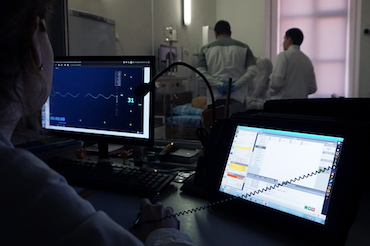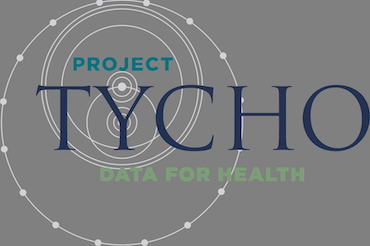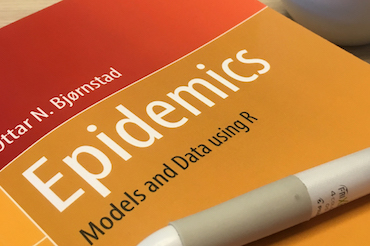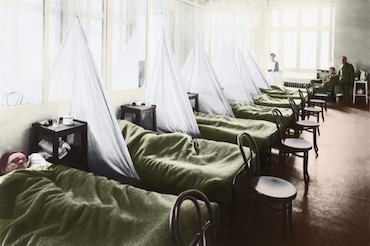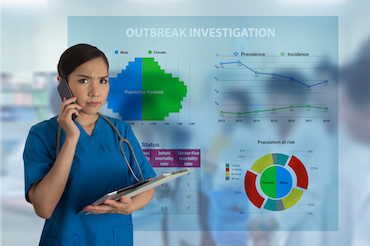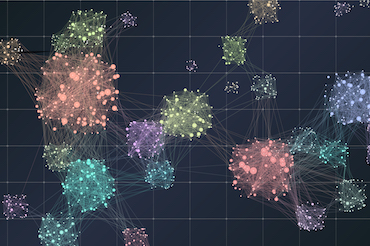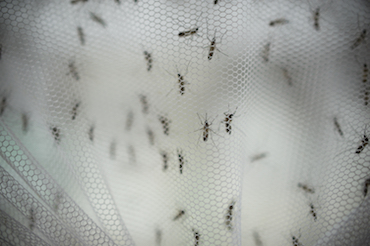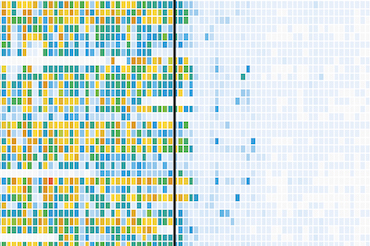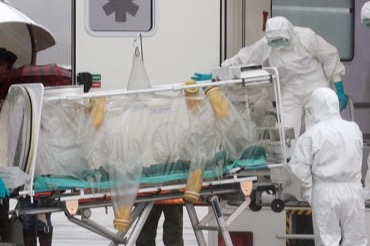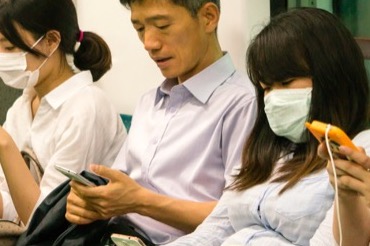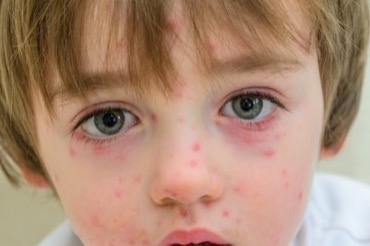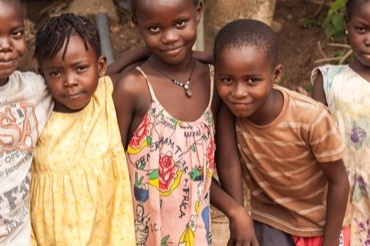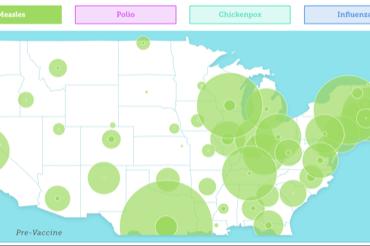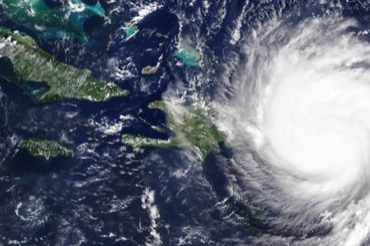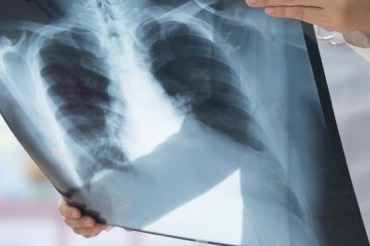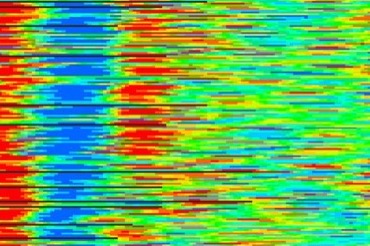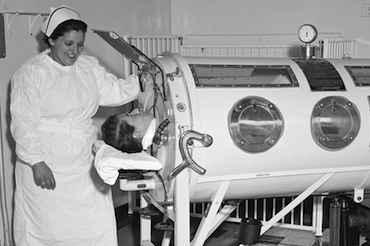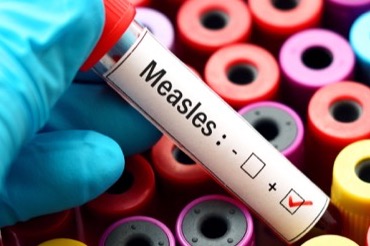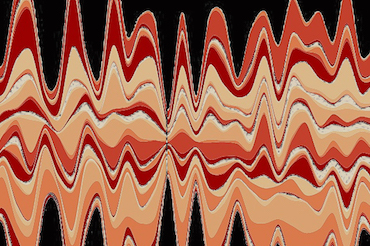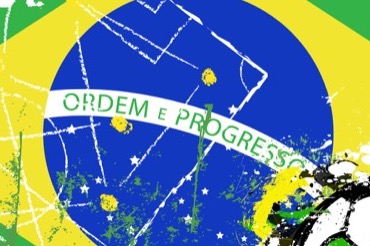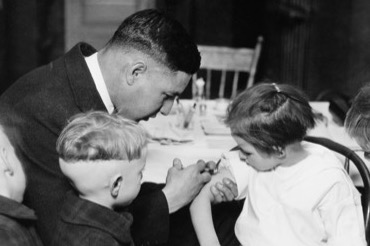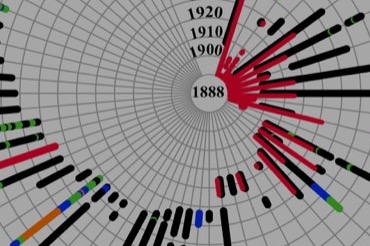15
Jun
2019
Point Process Models for the spread of Coccidioidomycosis, an infectious disease, in California
Jiajia Wang, from the University of California, Los Angeles, used Project Tycho data to evaluate the use of Hawkes point process models and recursive point process model in predicting the spread of coccidiomycosis in California.
1
Jun
2019
TensorCast: forecasting and mining with coupled tensors
Researchers led by Miguel Araujo, of Carnegie Mellon University, developed TensorCast, a method which addresses the forecasting problem on big time-evolving datasets when contextual information is available. They demonstrated TensorCast's forecasting results and anomaly detection..
6
May
2019
A Network-Based Compartmental Model For The Spread Of Whooping Cough In Nebraska
Kimia Ameria and Kathryn D. Cooper from the College of Information Science and Technology at the University of Nebraska at Omaha proposed a Network-Based SEIR (NB-SEIR) model of pertussis transmission. They used Project Tycho pertussis data to show that the NB-SEIR model estimate..
19
Apr
2019
Changes in historical typhoid transmission across 16 U.S. cities, 1889-1931: Quantifying the impact of investments in water and sewer infrastructures
Maile T. Phillips of Yale University, and colleagues, used data from Project Tycho to estimate seasonal and long-term typhoid transmission. They characterized seasonal and long-terms trends in typhoid transmission and quantified the relationship between infrastructure investments..
19
Mar
2019
Unraveling the social ecology of polio
Amarah C. Mauricio and Andrew Noymer, from the University of California, Irvine, used Project Tycho polio and typhoid fever data in their analysis of competing theories for the twentieth century expansion of polio.
22
Feb
2019
On the predictability of infectious disease outbreaks
Samuel V. Scarpino from Northeastern University and Giovanni Petri from the ISI Foundation used Project Tycho data to study the predictability of a diverse collection of outbreaks. The results demonstrate that outbreaks should be predictable but that accurate long-range forecasts..
20
Feb
2019
Integer-Valued Functional Data Analysis for Measles Forecasting
Daniel R. Kowal of Rice University used Project Tycho measles data for Texas to develop new methods for modeling and forecasting measles counts.
1
Feb
2019
VisGuides visualizations using Project Tycho data
Many people are using Project Tycho data to create visualizations using a variety of visualization tools, including Tableau, Python, RAWGraphs, and more, and posting their examples on VisGuides for feedback.
15
Oct
2018
Project Tycho 2.0: a repository to improve the integration and reuse of data for global population health
Researchers at the University of Pittsburgh Graduate School of Public Health, led by Willem G van Panhuis, created Project Tycho V2, which updates Project Tycho data and encodes it using standard vocabularies to improve compliance with FAIR principles.
1
Oct
2018
Epidemics: Models and Data using R
Ottar N. Bjørnstad of the Center for Infectious Disease Dynamics at the Pennsylvania State University, wrote a book and an accompanying R package on the analysis of epidemics using R. He used Project Tycho data in his examples.
17
Sep
2018
Data needs for forecasting influenza pandemics
Nicholas Reich from the Department of Biostatistics and Epidemiology at the University of Massachusetts Amherst wrote a blog post about creating plots of pneumonia deaths from two influenza pandemics, using Project Tycho data.
29
Aug
2018
R interface to Project Tycho 2.0 API
Éric Marty from the Department of Ecology at the University of Georgia created an R wrapper for version 2.0 of the Project Tycho API.
23
Aug
2018
Subacute sclerosing panencephalitis mortality, United States, 1979–2016: Vaccine-induced declines in SSPE deaths
Lia B. Pallivathucal and Andrew Noymer from the University of California, Irvine documented subacute sclerosing panencephalitis (SSPE) age-specific mortality. They used Project Tycho measles data as a comparison to their SSPE results.
19
Aug
2018
Exploring infections through data: Interactive visualisation of Measles in the USA
Ross Burton, a biomedical scientist and technology enthusiast, wrote an article on Medium about creating interactive plots of Project Tycho measles data using Python and Bokeh. He also made a video of the visualization tool and posted his code on Github.
1
Aug
2018
Essays in Education & Economics
Mary Elizabeth Glenn, from the University of Tennessee Knoxville, used polio data from Project Tycho to analyze parents’ responsiveness to the uncertainty represented by a polio outbreak. She examined how reported state-level polio incidence rates affected individual school enrol..
1
Aug
2018
A review of a model for imperfect vaccination, honeymoon periods and methods to characterize transient dynamics
Nazila Akhavan Kharazian at Queens University reviewed the VSIR model of vaccine failure and attempted to use linearization methods in ecology to characterize when and which models can display honeymoon periods. This study uses Project Tycho pertussis data to show an example of a..
1
Jul
2018
Homerun: scalable sparse-spectrum reconstruction of aggregated historical data
Led by Faisal M. Almutairi of the University of Minnesota, researchers created a novel data disaggregation method, called HOMERUN, that exploits an alternative representation of a sequence to reconstruct a higher resolution event sequence from a mixture of lower resolution sample..
16
Jun
2018
Heterogeneity Between States in the Health and Economic Impact of Measles Immunization in the United States
Angel Paternina-Caicedo and others at the University of Pittsburgh Graduate School of Public Health used measles data from Project Tycho to estimate the health and economic impact of measles vaccination in US states since 1964.
8
Jun
2018
Anticipating epidemic transitions with imperfect data
Researchers from the Odum School of Ecology at the University of Georgia, led by Tobias S. Brett, used Project Tycho measles data for California in the development of early-warning signals (EWS) for epidemic transitions.
1
May
2018
Heatmaply: an R package for creating interactive cluster heatmaps for online publishing
Researchers led by Tal Galili from Tel Aviv University, created an R package heatmaply to create interactive cluster heatmaps, and used Project Tycho measles data to demonstrate an example of its use.
19
Apr
2018
Ares: Automatic Disaggregation of Historical Data
A team of researchers led by Fan Yang of the University of Pittsburgh School of Computing and Information developed an automatic approach for re-constructing historical counts from possibly overlapping or incomplete aggregated reports, and evaluated the method using data from Pro..
18
Apr
2018
The association between tuberculosis and diphtheria
Stephen Coleman, from Metropolitan State University, used available Project Tycho data from 1906 to 1947 to assess the association between diphtheria and tuberculosis in five major cities: New York City, Chicago, Philadelphia, Detroit, and Boston.
16
Apr
2018
Variation in Wolbachia effects on Aedes mosquitoes as a determinant of invasiveness and vectorial capacity
Researchers led by Jessica G. King of the Universidade do Porto and Caetano Souto-Maior of the Instituto Gulbenkian de Ciência created mathematical models to investigate the conditions for Wolbachia invasion and its impact on dengue transmission. They used Project Tycho dengue da..
15
Apr
2018
GB-R: A Fast and Eective Gray-Box Reconstruction of Cascade Time-Series
Researchers led by Hyun Ah Song, of the Machine Learning Department at Carnegie Mellon University, developed an algorithm that effectively reconstructs time series counts from aggregated reports by careful infusion of domain knowledge, when compared with Project Tycho data.
24
Jan
2018
A shiny app to explore public health data from Project Tycho at all 3 levels.
Alison Wu, from North Carolina State University, created a Shiny app to explore and visualize Project Tycho data.
22
Jan
2018
Some datasets for teaching data science (R-package)
Rafael Irizarry from the Department of Data Sciences at Dana Farber Cancer Institute created the Data Science Labs R package for use in his data science courses. Irizarry used Project Tycho to show how to plot data in more then 2 dimensions.
13
Jan
2018
Sequential Clustering via Recurrence Network Analysis
Zhang Zhang from the University of Pittsburgh Department of Statistics created a new sequential clustering method based on nonlinear dynamic theories and exponential random graph models. Zhang used measles data from Project Tycho in a case study for this method.
23
Aug
2017
Data Stories - The impact of Vaccines on Measles
Vizlib, a data visualization company, created Vizlib Heatmap, a visualization extension for the Qlik Sense analytic platform. They demonstrated Vizlib Heatmap using Project Tycho data, creating heatmaps showing the impact of the measles vaccine.
7
Aug
2017
Project Tycho Utilities
Laurent Gautier, a data scientist, created Python code to load a SQLite database with Project Tycho Version 1 Level 2 data.
28
Jun
2017
Reproducing the WSJ Measles Vaccination Chart Using R
Michael Lee, a research and data professional, used Project Tycho data to reproduce the WSJ measles vaccination chart using R.
23
Jun
2017
Multiple peaks patterns of epidemic spreading in multilayer networks
Muhua Zheng, Wei Wang, Ming Tang, Jie Zhou, Stefano Boccaletti and Zonghua Liu discovered new features of two (or multiple) peak epidemic patterns and developed an edge-based theory to explain the numerical results. The authors used measles data from Project Tycho and the results..
25
May
2017
Synchronized and mixed outbreaks of coupled recurrent epidemics
Muhua Zheng, Ming Zhao, Byungjoon Min, and Zonghua Liu used measles data from Project Tycho to create a two-layered network model that can be used to explain recurrent epidemics. The two-layered model is a novel way to show both synchronized outbreak patterns and mixed outbreak p..
4
May
2017
Online cross-validation-based ensemble learning
David Benkeser, Cheng Ju, Sam Lendle, and Mark van der Laan of the Biostatistics Group from UCLA, Berkeley created flexible, ensemble-based online estimators and tested their performance by predicting hepatitis A incidence with data from Project Tycho.
5
Apr
2017
On the predictability of infectious disease outbreaks
Samuel V. Scarpino, from the University of Vermont, and Giovanni Petri, from the ISI Foundation, used 25 years of Project Tycho data on eight diseases to test how well prediction models can use past epidemiologic data to predict future outbreaks.
23
Mar
2017
A recursive point process model for infectious diseases
Frederic Schoenberg, Marc Hoffman, and Ryan Harrigan used measles data from Project Tycho to create a new model to explain how disease transmission rates are affected by low or high disease prevalence in the population.
21
Mar
2017
Impact of State Public Health Spending on Disease Incidence in the United States from 1980 to 2009
Researchers from Johns Hopkins Bloomberg School of Public Health, led by Reetu Verma, M.P.H., used Project Tycho data on mumps, pertussis, and rubella to evaluate the relationship between public health spending and the incidence of the three vaccine preventable diseases.
27
Feb
2017
Death and the Media: Infectious Disease Reporting During the Health Transition
Dora L. Costa from the University of California, Los Angeles and Matthew E. Kahn from the University of Southern California investigated how the media reported on infectious diseases in major U.S. cities over the last century. By combining weekly typhoid deaths and cases from the..
18
Feb
2017
Gather the level 2 dataset from tycho project
Bing Zhang from Sun-Yat Sen University wrote an R package to retrieve Project Tycho Version 1 Level 2 data using the Project Tycho API.
9
Feb
2017
Contagious Diseases: Maps and Data Analysis
Benjamin Lott used the measles dataset from Project Tycho to create tables, graphs and maps of measles cases in the United States from the 1920s to 2010.
27
Jan
2017
Temperature Influences on Salmonella Infections across the Continental United States
Christopher K. Uejio from the Geography Department at Florida State University studied how temperature changes impact Salmonella transmission in the United States. By using Salmonella data from Project Tycho, a degree (°C) rise in temperature resulted in a 1.3% to 5.9% increased ..
19
Jan
2017
Temporal Topic Modeling to Assess Associations between News Trends and Infectious Disease Outbreaks
Saurav Ghosh, Prithwish Chakraborty, Elaine O. Nsoesie, Emily Cohn, Sumiko R. Mekaru, John S. Brownstein, and Naren Ramakrishnan created a temporal topic model to investigate how accurately news reports about an outbreak follow the epidemiological dynamics of the outbreak. News i..
1
Jan
2017
H-FUSE: Efficient Fusion of Aggregated Historical Data
Zongge Liu, Hyun Ah Song, Vladimir Zadorozhny, Christos Faloutsos, and Nicholas Sidiropoulos created a new method to recover time sequence and counts data from aggregated historical records. H-FUSE uses domain knowledge efficiently and effectively in reconstructing historical cou..
21
Dec
2016
Limits to Causal Inference with State-Space Reconstruction for Infectious Disease
Sarah Cobey and Edward B. Baskerville from the University of Chicago Department of Ecology & Evolution studied the limitations of casual inference under convergent cross-mapping (CCM) methods that model infectious diseases. By using Project Tycho datasets of measles, mumps, pertu..
1
Oct
2016
SPEW VIEW Interactive Map of Disease Incidence
SPEWVIEW is a tool for visualizing historical diseases in the United States, created by PhD students and faculty from the Statistics Department at Carnegie Mellon University. The Project Tycho datasets that were used include diphtheria, measles, hepatitis A, mumps, rubella, polio..
1
Aug
2016
The effect of a prudent adaptive behaviour on disease transmission
The effect of human behavior on disease transmission was investigated by Samuel V. Scarpino, Antoine Allard, and Laurent Hebert-Dufresne. By creating a new dynamic network model based off of relational exchange, or the replacement of ill health-care workers and first responders w..
18
Jul
2016
The association between varicella (chickenpox) and group A streptococcus infections in historical perspective
Using Project Tycho data, Dr. Stephen Coleman from Metropolitan State University explored the temporal and spatial association between varicella (chicken pox) and scarlet fever from 1924 to 1932 in four major United States cities.
14
Jun
2016
Digital epidemiology reveals global childhood disease seasonality and the effects of immunization
Kevin M. Bakker, Micaela Elvira Martinez-Bakker, Barbara Helm, and Tyler J. Stevenson used chicken pox to study how well internet queries and Google Trends reflected the incidence of less-severe diseases. By using the varicella database from Project Tycho, the authors found that ..
19
May
2016
Quantifying the impact of the measles vaccine by estimating the number of measles cases prevented for each state from 1964 to 2010
Michael Sharbaugh from the University of Pittsburgh used Project Tycho data to estimate the number of measles cases prevented for each state in the United States since the vaccine was licensed.
4
Feb
2016
Persistent Chaos of Measles Epidemics in the Prevaccination United States Caused by a Small Change in Seasonal Transmission Patterns
This study led by Dr. Benjamin Dalziel and colleagues at Princeton University, the Pennsylvania State University, and the University of Pittsburgh used Project Tycho case counts for measles in 80 US cities from 1920 to 1940 to study seasonal patterns in cities the United States v..
20
Jan
2016
Disease History Interactive Map
This visualization of Project Tycho data was built by the students of Code 7370, a software engineer training program in San Quentin State Prison. Mentored by Dr. Micaela Martinez-Bakker at Princeton University, the students used the popular data visualization tools from D3.js to..
13
Jan
2016
Efficient Process Data Warehousing
Ying-Feng Hsu from the University of Pittsburgh used Project Tycho datasets to elaborate a process data warehousing architecture to large-scale heterogeneous historical data, and to demonstrate a conflict-aware data fusion strategy.
1
Jan
2016
Projecting Climate-Related Disease Burden: A Guide for Health Departments
Jeremy J. Hess, Shubhayu Saha, Paul J. Schramm, Kathryn C. Conlon, Christopher K. Uejio, and George Luber used Cryptosporidiosis data from Project Tycho to create a guide for health departments on how to measure anticipated disease burden resulting from climate change. The author..
15
Dec
2015
The historical association between measles and pertussis: A case of immune suppression?
Using Project Tycho data, Dr. Stephen Coleman from Metropolitan State University explored the temporal and spatial association between measles and pertussis (also known as whooping cough) from 1938 to 1954.
13
Nov
2015
Scalable Gaussian Processes for Characterizing Multidimensional Change Surfaces
This research, led by William Herlands, a PhD student in the Machine Learning and Public Policy program at Carnegie Mellon University, used Project Tycho weekly case count data for measles in US states from 1935 to 2003 to develop a scalable, multidimensional Gaussian process mod..
21
Oct
2015
The role of influenza in the epidemiology of pneumonia
Dr. Sourya Shresthra from Johns Hopkins Bloomberg School of Public Health used Project Tycho influenza and pneumonia datasets, together with other sources of information, to evaluate epidemiological interactions between these two diseases. This analysis was published in Scientifi..
20
Oct
2015
Region-wide synchrony and traveling waves of dengue across eight countries in Southeast Asia.
A team of researchers, led by Dr. Willem van Panhuis of the University of Pittsburgh, used Project Tycho data on dengue cases in eight southeast Asian countries to examine the relationship between dengue cases and climate patterns, such as El Niño events.
13
Oct
2015
Climate and Viral Illness: El Niño Event Linked to Dengue Epidemics
Dr. Francis Collins, director of the National Institutes of Health, mentioned a study that used Project Tycho data in a post on his blog about El Niño events and dengue epidemics. The study, conducted by researchers at the University of Pittsburgh, used data of 3.5 million cases ..
24
Jun
2015
Asymptomatic transmission and the resurgence of Bordetella pertussis
Benjamin M. Althouse and Samuel V. Scarpino, from the Santa Fe Institute, used Project Tycho data on pertussis (whoooping cough) in the United States form 1922-2012 to evaluate the asymptomatic transmission of pertussis in the United States and the United Kingdom.
19
Jun
2015
Unraveling the Transmission Ecology of Polio
Researchers, led by Michaela Martinez-Bakker, used Project Tycho polio datasets to explore the spread of polio for each state in the United States of America between 1931-1954.
15
Jun
2015
Dynamics of Pertussis Transmission in the United States
F.M.G. Magpantay and P. Rohani used Project Tycho data containing pertussis (whooping cough) case counts from 1938-1955 in the United States of America. The reasearchers, who are affiliated with the University of Michigan and the Fogarty International Center, examined the inciden..
31
May
2015
Why Should You Get Immunized Against Measles?
Allison Hydzik and Nicole Davison, of the University of Pittsburgh Medical Center, cited the University of Pittsburgh Graduate School of Public Health's Project Tycho measles dataset that has shown the number of cases that have been estimated to have been prevented by the introdu..
8
May
2015
Long-term measles-induced immunomodulation increases overall childhood infectious disease mortality
Researchers from Princeton University, Emory University, the US National Institutes of Health Fogarty International Center, and Erasmus University Medical Center in The Netherlands led by Dr. Michael Mina, postdoctoral fellow at Princeton, published a study that examined the pres..
7
May
2015
Efficient information integration system for temporal and spatial data
Pei-Ju Lee from the University of Pittsburgh, developed an information system that integrates temporal and spatial data efficiently.
1
May
2015
Declining Mortality Inequality within Cities during the Health Transition
Dora L. Costa from the University of California, Los Angeles and Matthew E. Kahn from the University of Southern California analyzed death rates from major cities using the typhoid fever database from Project Tycho. The authors compared the mortality trends with economic indicato..
15
Apr
2015
Interactive streamgraph visualization of measles cases over the 20th Century
Dr. Nick Schurch, a senior biostatistician at University of Dundee, created an interactive streamgraph visualization of the mean weekly number of measles cases over the 20th century in US states.
14
Apr
2015
The availability and consistency of dengue surveillance data provided online by the World Health Organization.
Researchers from the University of Pittsburgh, led by Irene Ruberto, created Project Tycho datasets for dengue in over 100 countries by utilizing available reports from the World Health Organization (WHO), the WHO Southeast Asia Regional Office (SEARO), the WHO Western Pacific Re..
11
Feb
2015
Battling Infectious Diseases in the 20th Century: The Impact of Vaccines
Tynan DeBold and Dov Friendman, from The Wall Street Journal, published interactive heat maps that illustrate case frequency of seven major vaccine preventable diseases in the United States using Project Tycho data. Case counts are available for all 50 states. By marking when a v..
3
Nov
2014
Worries Beyond Ebola: Infographic Shows What Else Is On America's Deadly Disease Watchlist
Dan Bigman, the Managing Editor for Business News at Forbes, published an infographic from Dr. Wilbert van Panhuis, a reasearcher from the University of Pittsburgh. The infographic used Project Tycho data to depict the years medical professionals were required to report 58 infect..
24
Aug
2014
FUNNEL: automatic mining of spatially coevolving epidemics
Researchers from Kumamoto University in Japan, the University of Pittsburgh, and Carnegie Mellon University led by Dr. Yasuko Matsubara, used Project Tycho historical time series data to create FUNNEL and FUNNELFIT. This research used weekly case counts from Project Tycho for a r..
31
Jul
2014
Risk of dengue for tourists and teams during the World Cup 2014 in Brazil
Researchers, led by Willem G. van Panhuis of the University of Pittsburgh, evaluated Tycho data on dengue in Brazil from 2001-2013 to estimate the number of expected dengue cases among tourists and teams in Brazil during the 2014 World Cup.
22
May
2014
Python wrapper for Project Tycho MMWR repository
Dr. Caitlin Rivers at Johns Hopkins Bloomberg School of Public Health created a Python wrapper to access Project Tycho datasets and made the code availalbe on Github.
7
Apr
2014
Graph Database - Project Tycho
Greg Ricker wrote a blog series in Spatial Information Science and Engineering using Project Tycho data to create a Graph Database. The author used the Project Tycho API to analyze datasets for influenza, rubella, cholera, malaria, mumnps, measles, smallpox, and Yellow Fever.
6
Mar
2014
The age of vaccines
Tony Scully, a science editor at Nature, used Project Tycho data on various childhood diseases to publish this 2-page infographic showing the impact of childhood vaccination on the reduction of seven vaccine-preventable diseases in the US. Scully used annual Project Tycho case co..
28
Nov
2013
Contagious diseases in the United States from 1888 to the present.
Reaserchers from the University of Pittsburgh and Johns Hopkins University, led by Dr. Willem G. van Panhuis, used Project Tycho data to estimate the number of prevented cases of seven diseases since the introduction of a vaccine. The seven diseases were polio, measles, rubella, ..
27
Nov
2013
The Vaccination Effect: 100 Million Cases of Contagious Disease Prevented
Steve Lohr, a writer for The New York Times, wrote a piece of summarizing the findings of a group of researchers at the University of Pittsburgh Graduate School of Public Health. The researchers digitized 88 million reports of congatious disease cases from the Centers for Disease..






